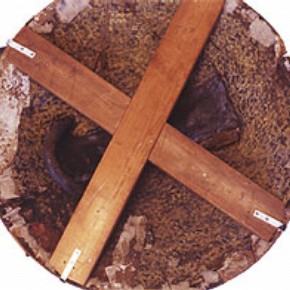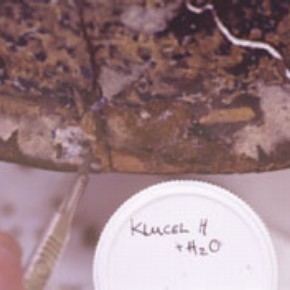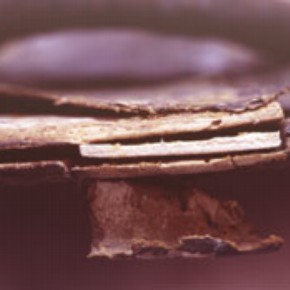Conservation Journal
Autumn 2005 Issue 51
Into battle: Conservation of a Venetian shield
The treatment of the reverse side of a gilt and glazed leather Venetian parade shield (24-1881) that was probably made for Wolf Dietrich von Raitenau, Prince Bishop of Salzburg (1587-1611) around 1600 posed numerous problems due to the instability of the leather. The shield had, until recently, been displayed in the Jones Galleries at the V&A. The outer side of the shield, of glazed, painted and gilt decoration on the leather is adhered to a double timber substrate constructed of timber boards, laid in opposing directions. The reverse or back side of the shield is lined with leather on a gesso ground, the leather polychromed to affect a mottled appearance. The leather arm and handle grip are attached to a padded leather support with iron rivets. The timber cross frame support on the reverse of the shield has restricted any environmental movement of the wood (Figure 1). The environmental effects upon the leather lining are evidence that the leather within the bowl has distorted due to internal stresses caused by the hydroscopic nature both of the timber and leather, visible as splits and general degradation.

Figure 1. Cross frame on reverse side of shield. Photography by Nigel Bamforth (click image for larger version)
The exterior is stable, minor timber fractures and old woodworm infestation boreholes are visible but do not generally affect the overall exterior appearance of the object. This is in contrast to the verso that has suffered major losses, tears, lifting and curling of the leather and fractured timber around the inner rim. Old remedial conservation treatment is evident where a paper support adhered to the leather and overlapping the rim has clearly failed, leaving leather losses and intruding upon the aesthetic appearance of the object. The hand grip and padded support are discoloured with white salts.
The reverse of the shield was noted, the object then supported on Plastazote wedges and the timber cross frame removed, allowing the object to relax. The R.H. in the Furniture Studio was monitored and found to fluctuate between 15 and 78%. The environmental monitoring of Gallery 1C, from where the object was previously located, was also noted. A reading was taken from the V&A OCEAN monitoring system recording the same previous nine months as R.H. fluctuations of between 15 and 64%. The temperature registered similar fields, confirming that the effect of moving the object to the studio was not detrimental to its stability.

Figure 2. Removal of old paper support. Photography by Nigel Bamforth (click image for larger version)
Conservation treatment proceeded with the removal of remnants of the paper support around the rim. Methyl cellulose and Klucel G (hydroxypropyl cellulose) gel soluble in water was applied, the latter being selected and left to impregnate the paper for approximately three minutes (Figure 2). This allowed the paper to be lifted from the leather without causing undue surface instability. Any adhesive residue left on the surface was easily removed with acetone applied on cotton swabs. A rewarding factor was the revealing of a broad yellow polychromed band around the inner rim.
Due to the fractured and curled state of the leather, humidification was required to flatten the leather prior to conservation and consolidation. A technique developed by Alan Derbyshire, Head of Sculpture, Metals, Ceramics and Glass, for flattening ivory miniatures was employed. A Goretex pad was laid upon the distorted leather, moistened blotting paper laid on to the Goretex and a barrier film of Melinex placed over the paper. This was gently weighted with small lead shot contained within specimen bags, allowing the bag to take the form of the distorted leather. The procedure was repeated until satisfactory results were achieved. The blotting paper was finally removed and the object allowed to gain equilibrium with the environment, whilst still being gently weighted. Areas of timber fractures surrounding the shield edges were glued with Canadian fish glue, care being taken to re-enforce any fragile timber due to old infestation. The de-lamination of the carcase boards was problematic; the tension within the timber did not allow the boards to be re-glued together, as this would induce further problems to the substrate. To overcome the instability of the outer rim and act as a support for the overhanging leather, fillets of balsawood were inserted and glued in place with Canadian fish glue (Figure 3).

Figure 3. Fillets of balsa wood inserted between the boards. Photography by Nigel Bamforth (click image for larger version)
To address the needs of the fragmented and torn leather, experiments were conducted to find suitable materials to support the tears. A combination of Lascaux 498HV & 360HV (50:50) (butyl acrylate) were selected, offering both weight and flexibility. A medium weight Japanese paper would allow the leather to flex and the paper to give way if the occasion arose, alleviating any stress on the leather. The Japanese paper was torn to the required shapes and adhesive applied to the upper face only. The support was then eased under the leather with a spatula until satisfactorily placed. The adhered leather was then weighted with the lead shot bags placed upon a barrier of Melinex film, and formed to apply pressure to the areas of adhesion. This paper support system was satisfactory for all the areas of leather tears and was also used to act as a bridging material between losses of leather. When dry a water colour paint application toned the visible paper to the colour of the leather surface. A pH measurement of 5.5 confirmed the general stability of the leather, although conservation of small areas of friable leather was undertaken with Pliantex (ethyl acrylate) in toluene (2-10%) where necessary, and applied by brush. At this stage it was now possible to undertake surface cleaning on areas of the polychrome stippling, these were merely dusted with a small paint brush into a netted vacuum in preference to the use of a chemical sponge or solvent. The handgrip and padded arm support were cleaned with Stoddard solvent (white spirit) applied on cotton swabs to remove the white film impregnating the leather.
The conservation project was successful. Although the losses intrude upon the look of the object, but the fragmented leather is now sufficiently stable to be redisplayed.
Suppliers
Plastazote: Polyform Ltd., Cherry Ct Way, Stanbridge Road, Leyton Buzzard, Beds. Tel 01525 852 4444
Melinex: Polyester Converters, Polymex House, 49-53 Glengall Rd, London SE15 6NF. Tel 020 7740 9740
Methyl cellulose, Klucel G, Goretex, Lascaux 4989HV, Lascaux 360HV and Pliantex: Conservation Resources UK, Unit 2, Ashville Way, Off Watlington Road, Cowley, Oxford, OX4 6TU
References
Autumn 2005 Issue 51
- Editorial
- The new miniatures gallery
- Fur trade legacy
- Into battle: Conservation of a Venetian shield
- Smart and Techno Fabrics: fundamental properties of new fibres and their future
- RCA/V&A Conservation: Study trip to Rome, April 2005
- Presentations involving V&A staff accepted for the ICOM-CC 14th Triennial Meeting held from 12-16 September 2005 in The Hague
- Lustre ceramics analysis using the MOLAB facilities
- RCA/V&A Postgraduate Conservation Programme
- Printer friendly version